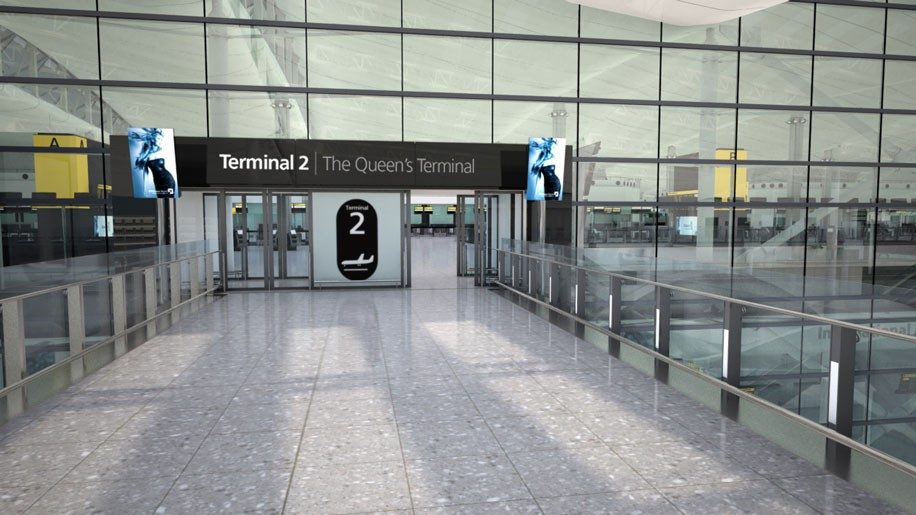
Heathrow’s revamped Terminal 2 is almost complete. Graham Smith takes a look at what travellers can expect
Heathrow will again find itself at the centre of attention in June, when it opens Terminal 2: The Queen’s Terminal. No doubt keen to avoid a repeat of the problems that beset the 2008 unveiling of T5, it will this time be taking no chances. From June 4, the £2.5 billion facility will open in stages.
The first service into the terminal will be operated by United the same day, with flight UA958 from Chicago scheduled to land at 0555. The airline will have sole use of the terminal for two weeks until fellow Star Alliance carriers Air Canada, Air China and ANA join it on June 18. The other Star airlines will then move over in stages, with all 23 in place by the end of October.
Star Alliance, which accounts for almost a quarter of all traffic at the airport, will dominate the Queen’s Terminal. The only other carriers that will be operating out of T2 will be Aer Lingus, Virgin Atlantic Little Red and Germanwings.
Colin Matthews, Heathrow’s chief executive, said: “Opening a new terminal is incredibly complex and teething troubles are inevitable. We’ve planned carefully to minimise any disruption for our passengers.
“With construction complete, we’re spending months testing, learning, improving and testing again – working with 14,000 volunteers to run full trials of the facilities and running 1,700 staff familiarisation training sessions.”
John Holland-Kaye, the airport’s development director, said passengers would be wise to expect some disruption. He said: “The chance of a completely smooth opening for any airport terminal in the world is low. The chance of delays in week one is very high. By week two, it will be a lot less [likely]… Look at T5 – after a few weeks, everything was running smoothly.”
Terminal 2 is expected to serve up to 20 million passengers a year, with an average of 55,000 travelling through it each day. Upon entering the main building, they will be greeted by state-of-the-art technology. There will be four check-in zones with “next-generation” desks designed to create a more informal atmosphere. In a world first, any passenger flying with any airline can check-in at any kiosk.
At each, an agent will come out and welcome the passenger before carrying out the usual checks. There will also be a scanner for passengers to open their booking direct from their mobile device. Each airline will also have a more traditional check-in desk, and a fast bag-drop where passengers will simply scan their boarding pass and baggage tag.
Hanging from the ceiling of the entrance courtyard will be one of the longest permanent sculptures in Europe. Slipstream by Richard Wilson is designed to represent “the shape a stunt plane would carve through space, starting as an abstract volume and becoming recognisable at its furthermost point”. At 76 metres, the aluminium artwork will be longer than an A380 aircraft.
Surrounding this plaza will be high-level walkways made out of glass. North-facing skylights will ensure that plenty of natural daylight fills the terminal from check-in to boarding.
The two-level departure area will have ten-metre-tall windows overlooking the airfield. There will be no corridors leading to enclosed waiting rooms; instead, the open gate areas will form part of the main departure lounge.
A moving walkway beneath the airfield links the main terminal to the satellite pier, known as T2B, which welcomes long-haul passengers via a glazed atrium. The main terminal will have 12 boarding gates, two of which will be A380 compatible, while there will be 14 in T2B, eight of which will accommodate the superjumbo.
The terminal will contain 63 shops, bars and restaurants, including seven eateries with airfield views. The nine outlets new to Heathrow will be Case Luggage, Bottega Veneta, Heston Blumenthal’s the Perfectionists’ Café, Ca’ppucino, London’s Pride pub by Fuller’s, John Lewis – the retailer’s first airport store – and restaurants La Salle, Wondertree and the Gorgeous Kitchen.
United, Air Canada and Singapore Airlines will all have their own lounges at the terminal, and there will also be a Lufthansa-branded Star Alliance lounge, an Aer Lingus facility and a Plaza Premium Lounge for paying guests.
Details about the United and Air Canada venues remain under wraps, although Bob Schumacher, United’s managing director of sales for the UK and Ireland, told Business Traveller that his airline’s “spectacular” United Club and United Global First facilities would cover an area of 2,043 sqm and would be in the style of United’s new Club lounges.
Opening in October, Lufthansa’s facility will be in the main terminal building. Measuring 1,600 sqm, it will be separated into Business and Senator sections, collectively seating 350 guests. It will be open to Star Alliance business and first class passengers and will be the carrier’s largest facility outside Germany.
The Plaza Premium Lounge will open in June and will be the group’s first in Europe. It will feature a live cooking station serving made-to-order dishes, a champagne bar also serving tapas, an à la carte menu and a spa.
For many passengers, Terminal 2’s main calling card will be the improved flight connections that will arise as a result of partner airlines moving closer together. For Star Alliance passengers, transfer times will be substantially reduced, to a standard minimum connection time of 60 minutes, and will end the stress of dashing to another terminal to catch a connecting service.
The terminal’s opening will doubtless attract a huge amount of media coverage. It’s been a long journey since the original terminal closed in 2009, some 54 years after it was opened by the Queen.
For a more detailed look at what the facility will offer its passengers, look out for our June issue.












